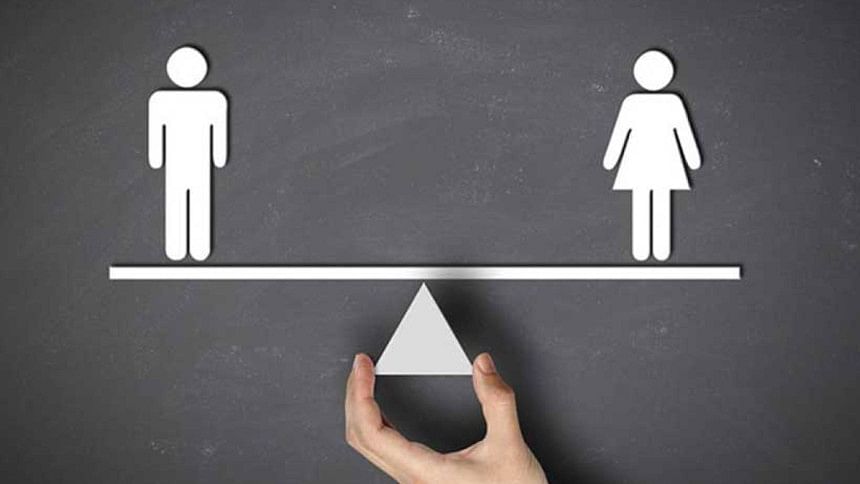What causes the inequality in life-expectancy between men and women?

Women are sometimes considered to be the weaker sex because men on average are taller, more muscular, and seemingly stronger than women. Medical science, however, has a different story to tell us: women are biologically stronger than men. In all countries across the world, women consistently live longer than men on average. This is also true for many other species of mammals.
The natural sex ratio at birth is male-biased, with 105 boys born on average against 100 girls on a global level. As the offspring grow up, males die in greater numbers than females at any given age, leading to a more balanced sex ratio in adult age. The population sex ratio again reverses in old age, with women outnumbering men in most countries. Consequently, around 90 percent of all supercentenarians (110-plus years old) living on the planet today are women.
The ongoing coronavirus pandemic further reminds us of the gender gap in mortality. In countries with available data, Covid-19 has been found to be killing more men than women (The New York Times, February 20, 2020). In Bangladesh, the number of deaths from Covid-19 is nearly four times higher among men compared to women. The higher prevalence of fatal diseases in men and the stronger immune system in women are presumably driving the gender differences in Covid-19 mortality globally.
Women usually report more psychological problems while men suffer more from severe and life-threating illnesses like heart diseases, stroke and cancer. These diseases are the major killers of our time and the main culprits for premature deaths and gender gap in mortality worldwide.
Women face gender discriminations at every sphere of the society, which limit their potential to maximise health and wellbeing. Yet, women paradoxically seem to be the healthier sex. The mechanisms that underlie the gender-health paradox are complex and not fully understood. Several biological and social mechanisms are suggested as explanations.
From a biologic point of view, men are naturally programmed to die earlier than women at the very moment of conception. Available evidence indicates that the male foetus is biologically weaker and more vulnerable to pregnancy complications than the female foetus. Moreover, the neonatal and infant mortality rates are higher in boys compared to girls. These sex differences at birth provide the foundation for the biologic explanation of male disadvantage in life-expectancy.
The sex hormones are argued to play a crucial role in the female advantage in longevity. The female sex hormone oestrogen is protective of cardiovascular diseases and is partly responsible for lower incidence of such diseases in women until menopause. By contrast, the androgen hormone, which is higher in men, is associated with higher risk of cardiovascular diseases.
The stronger female immune system is another factor that could contribute to the longevity gap. Female bodies are known to produce larger amounts of antibodies compared to males. This offers females an increased capacity to fight off respiratory, bacterial, and viral infections including the deadly Covid-19.
Moreover, female bodies carry higher amounts of the beneficial cholesterol (HDL) which protects against heart diseases. Men are disadvantaged even in the distribution of fat because they tend to accumulate excess fat around the stomach while women tend to carry excess fat in the hips and thighs. Any excess fat is harmful, but abdominal fat is more dangerous for cardiovascular health.
Genetic disorders are sometimes held responsible for excess morality in men. A damaged gene on the X chromosome can be naturally compensated by a similar gene in the second X chromosome in women, but not in men due to the lack of double X chromosomes. The higher infections, congenital disorders, and deaths in male babies are possibly an expression of their lack of double X chromosomes.
Furthermore, the mitochondrial DNA, which is known as the powerhouse of cells and is believed to be exclusively inherited from the mother, leads to male-specific harmful mutations in the mitochondria. The mitochondrial dysfunction is associated with ageing and chronic diseases.
If biology were the sole cause behind the gender gap in life-expectancy, one could expect the gap to be relatively constant over time and across societies. However, the gender gap in life-expectancy considerably varies by time and contexts, suggesting that social forces are in operation to drive the trends. For instance, a Bangladeshi boy born today is expected to live 3.8 years shorter than a girl while the corresponding male-female gap is 10.5 years in Russia.
Thanks to medical advances and improved standard of living, global life-expectancy linearly went up by three months per year (i.e., 6 hours a day) from 1841 to 2000. However, it increased at a much slower rate in men than in women, resulting in a wider gender gap.
Men are more exposed to work-related stress and unhealthy behaviours, e.g., smoking and alcohol abuse, which are responsible for their lower longevity. Furthermore, men are typically disadvantaged by occupational hazards and so-called masculine behaviours that are highly risky. As a result, they die disproportionately in work-related accidents, car crashes, war, and sporting activities.
The male sex hormone testosterone is believed to be responsible for predisposing men to risky behaviours. This is why, perhaps, research finds a link between marriage and increased life-expectancy in men but not in women. Marriage protects men from risky social habits whereas women are less prone to risky behaviour regardless of their marital status.
Compared to the past, the gender gap in global life-expectancy has narrowed in recent years. This is unsurprising given that women are increasingly entering the workforce and adopting health-damaging lifestyles like smoking and drinking. An interesting case in point is Sweden where females smoke more than males and the male-female longevity gap is relatively low. Improved medical management of fatal diseases might also have contributed to the reduced gap.
Women are evidently the healthier sex and real champions in the ultimate game of life. Nature has given women a biological advantage over men, perhaps to compensate for the structural disadvantages they experience in the society. Biology is, of course, only a part of the full story since it cannot answer why the female advantage in life expectancy would fluctuate over time.
The biological gap in life-expectancy between women and men is a natural destiny which no society can avoid. However, the social gap in life-expectancy is unjust and unfair. We can rarely alter our biological make-up, but we can certainly promote healthy lifestyles and design a society where both men and women will have a fair chance to maximise their health potentials.
M Zakir Hossin is a Managing Editor at the European Journal of Public Health, Oxford University Press, UK and a PhD fellow at Karolinska Institute, Stockholm, Sweden.

 For all latest news, follow The Daily Star's Google News channel.
For all latest news, follow The Daily Star's Google News channel. 



Comments